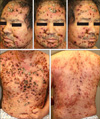Dear Editor:
Primary cutaneous aggressive epidermotropic CD8+ cytotoxic T-cell lymphoma (pCAE-CD8+CTCL) is an aggressively proliferating cutaneous lymphoma expressing CD8+ cytotoxic phenotype1.
A 61-year-old man presented with extensively diffuse erythematous plaques on the trunk, upper extremities, and face which had central necrosis with oozing and crust formation (Fig. 1). He was originally suffering from mild psoriasis treated with topical agents intermittently, but he complained that his skin problems suddenly evolved to the current pattern a year ago. He denied any previous or family history of skin cancers. Histopathologic examination performed at another hospital he visited earlier showed nonspecific ulcers in the background of mixed inflammatory cells. Oral prednisolone, cyclosporine, and acitretin were tried but not effective. Eventually he was referred to Seoul National University Hospital for exact diagnosis and treatment.
When he visited Seoul National University Hospital for the first time, a number of ulcerating nodules with yellowish pus were occupying most of his skin lesions, making impossible to grasp the initial appearance of the disease. Repeated wet dressing with intravenous administration of antibiotics to improve ulcers resulted in a reduction of the discharges and exposed the several precursor lesions. We took a skin biopsy again, and it displayed diffuse aggregates of atypical lymphoid cells with a pagetoid spreading of epidermotropism (Fig. 2A). Spongiosis and necrosis were detected in epidermis and perivascular infiltration of tumor cells was seen in upper dermis (Fig. 2B). The proliferating lymphocytes indicated strong labelling with CD3 (Fig. 2C), CD8 (Fig. 2D), and were negative for CD4, CD20 and CD56. Some cells focally expressed CD30. Molecular analysis exhibited monoclonal rearrangement of TCR genes. Based on these clinical and histologic profiles, he was finally diagnosed with pCAE-CD8+CTCL. He was transferred to the hemato-oncologic division for further systemic evaluation, but he was lost to follow-up due to his preference to be treated at a nearby hospital.
According to both the the World Health Organization (WHO)-European Organization for Research and Treatment of Cancer 2005 and the WHO 2008 classifications, pCAE-CD8+CTCL is classified as a provisional entity which is a rare subtype belonging to cutaneous T-cell lymphoma2. Only less than 60 cases have been reported worldwide and this is probably the first publication of Korean patient. Chromosomal instability and haploinsufficiency for TP53 subsequently affecting p14ARF-Mdm2-p53 tumor suppressor protein pathway observed in pCAE-CD8+CTCL are suggested to be responsible for its unfavorable clinical course3. The diagnosis of pCAE-CD8+CTCL should depend on a comprehensive integration of clinical and immunohistopathological features. The typical clinical presentation is the abrupt onset of aggressive widespread plaques and tumors often ulcerated4, which is consistent with our case. CD8+ and CD4− phenotype of tumor cells are essential to establish the diagnosis of pCAE-CD8+CTCL, whereas the expression of other markers is variable. Atypical lymphocytes are usually positive for CD3, CD45RA, βF-1, and TIA-1 and negative for CD30 and CD45RO, with a high Ki-67 proliferation index in most cases4. Various therapeutic regimens are attempted from local regional therapy to systemic multi-agent chemotherapy or stem cell transplantation, but treatment is extremely challenging15. The prognosis of pCAE-CD8+CTCL is very poor, due to its high metastatic and relapsing tendency with a low response to treatment4. Herein, we described the first Korean patient of pCAE-CD8+CTCL, a particularly rare entity characterized by distinct clinicopathological features.
Figures and Tables
Fig. 1
Widespread eruption of erythematous plaques, and papulonodular lesions involving central ulcers on upper body and face.

Fig. 2
(A) Lichenoid and strongly epidermotropic infiltration of atypical lymphoid cells in epidermis and upper dermis (H&E, ×100). (B) Epidermal spongiosis and necrosis with scattered lymphocytes accompanying a perivascular distribution in dermis (H&E, ×400). (C) Immunohistochemistry indicating that the tumor cells were positive for CD3 (×100) and (D) CD8 (×100).

References
1. Gormley RH, Hess SD, Anand D, Junkins-Hopkins J, Rook AH, Kim EJ. Primary cutaneous aggressive epidermotropic CD8+ T-cell lymphoma. J Am Acad Dermatol. 2010; 62:300–307.

2. Choi M, Park SY, Park HS, Byun HJ, Cho KH. A case of primary cutaneous CD4 positive small/medium T cell lymphoma. Ann Dermatol. 2011; 23:76–80.

3. Kato K, Oh Y, Takita J, Gunji Y, Kobayashi C, Yoshimi A, et al. Molecular genetic and cytogenetic analysis of a primary cutaneous CD8-positive aggressive epidermotropic cytotoxic T-cell lymphoma. Int J Hematol. 2016; 103:196–201.





 PDF
PDF ePub
ePub Citation
Citation Print
Print


 XML Download
XML Download